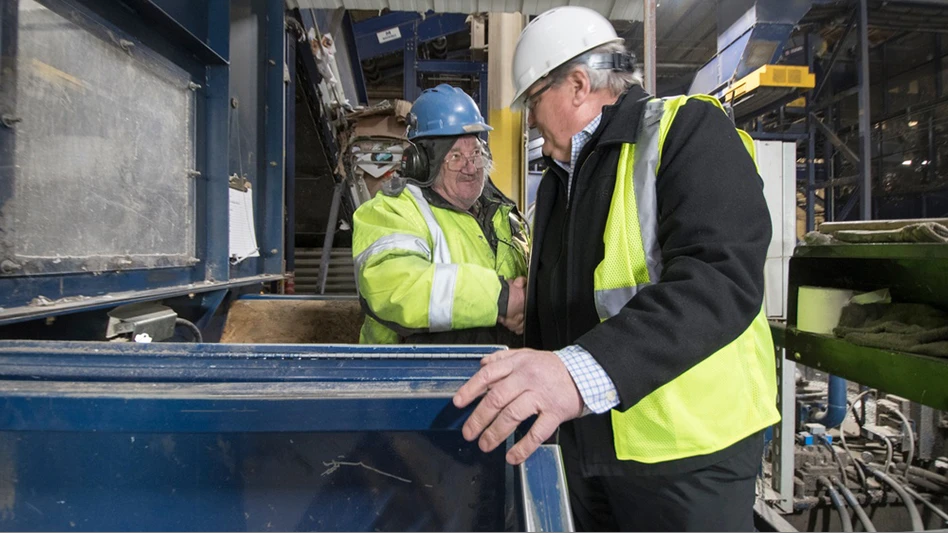
Over the years, Leck Waste Services, a regional refuse company based in Ivyland, Pennsylvania, has become increasingly tech savvy.
While operating the company’s collection vehicles, ranging from front loaders to fully automated collection trucks, drivers are tasked with using multiple systems, including arm-mounted digital scales designed by Eugene, Oregon-based Air-Weigh as well as fleet management software from San Diego-based Soft-Pak, which offers real-time GPS tracking, mapping, route productivity and other features for the driver. Leck Waste also uses Downers Grove, Illinois-based Dover’s 3rd Eye, a camera system that captures and documents in-cab and external events to improve safety and profitability of fleet operations.
While technology and fleet management software allow Leck Waste and other haulers to optimize routes and increase profitability, each solution comes with a price.
"We need the data and information to be able to run our business, but we need to do it in a safe way.” –Jason Leck, president and owner of Leck Waste Services.
“There’s literally no real estate left inside the truck,” says Jason Leck, president and owner of Leck Waste Services.
An industry-wide issue
Two years ago, the issue of in-cab design came up when Leck and other industry advocates, including Tony Romano of 3rd Eye, spoke on a technology panel at WasteExpo.
“In a conventional truck, there seems to be a little bit more cab space, but when you move into the cab design in a front loader or even a semi-automated or fully automated collection truck, with all the control panels that are installed inside the cab, there’s very limited space,” Leck says. “Then, when you start adding additional technology and mounting tablets and driver-facing cameras, we’re starting to fight for real estate.”

The problem, Leck says, is that each piece of technology his drivers use requires its own tablet or display screen and space to be mounted inside the cab. Not only does this pose logistical problems, it creates a safety issue. With so many different platforms operating within a truck, drivers can easily become distracted.
“Accidents typically happen when your driver has to stop what he’s doing in the process of servicing something to do something in the cab, and then he goes back to what he’s doing and starts to drive again,” Leck says. “Are we creating an issue where we require drivers to be touching or looking at tablets every time they service an account? We need the data and information to be able to run our business, but we need to do it in a safe way.”
Leck says the panel conversation at WasteExpo yielded a potential solution: The industry needs to create a standard for truck design and there needs to be collaboration between truck manufacturers and technology solutions providers to come up with a better way to implement fleet management hardware in vehicle cabs. Leck says the panel agreed that the best solution would be if an industry trade association, such as the National Waste & Recycling Association (NWRA), Washington, developed a standard for in-cab design “for how [manufacturers and software providers] share that space,” Leck says.
The panel proposed using a “central device” inside the cab to access the different applications as well as allocating one location inside the truck for the tablet “that’s already built into the dash” of the truck.
“Our thought is there is this ability for all these technologies and routing software to be utilized on one tablet in the vehicle that is designed to be placed in a certain location for the driver in a user-friendly area,” Leck says. “All the software that’s being developed should have to be able to work on that system that the driver could use. It would be cleaner, easier and safer if all those things didn’t have to be independently installed in the cab.”
A call for collaboration
Leck says while the industry recognizes there is a problem, the conversation hasn’t yielded a solution, yet. One of the challenges, he says, is getting truck manufacturers and software companies on board.
"It would be cleaner, easier and safer if all [these technologies] didn’t have to be independently installed.” –Jason Leck, president and owner of Leck Waste Services.
“They designed their product and they want to sell their products individually,” Leck says. “We want to use these products, but we have to have one universal point for everything in the truck to be displayed.”
Kirk Sander, chief of staff and vice president of safety and standards at NWRA, says the association’s safety committee is aware of the cab design issue and has been working with manufacturers on a solution. He also says the conversation around the placement of technology inside trucks opens the door to discuss other driver-related issues regarding cab layout. For example, the location of the parking brake is not always prominent enough to get the attention of younger drivers in the field, who are used to driving automatic vehicles, he says.
“I think technology is the best way to start the conversation, but I think technology it just a piece of the conversation of what the cab layout should look like,” he says.
Of the technology piece, Sander says, “This comes down to the driver experience on limiting items, such as screens and buttons. We recognize the need for a better user experience, not only to reduce distraction, but to improve efficiency and safety of our drivers.”
This article originally appeared in the March issue of Waste Today.
Latest from Waste Today
- Convertus finalizes permits for Ontario AD facility
- Defunct electronics recycling companies ordered to pay $3M for hazardous waste violations in Ohio
- Tacoma, Washington, launches smart camera technology pilot
- Pride Disposal sees efficiency gains with Hydrotex BIO-XPL hydraulic fluid
- Techbros launches AI-integrated electronics processing facility
- Understanding interchange optimization
- Account Updater: Keeping customer credit cards always up-to-date
- Understanding credit card fees





